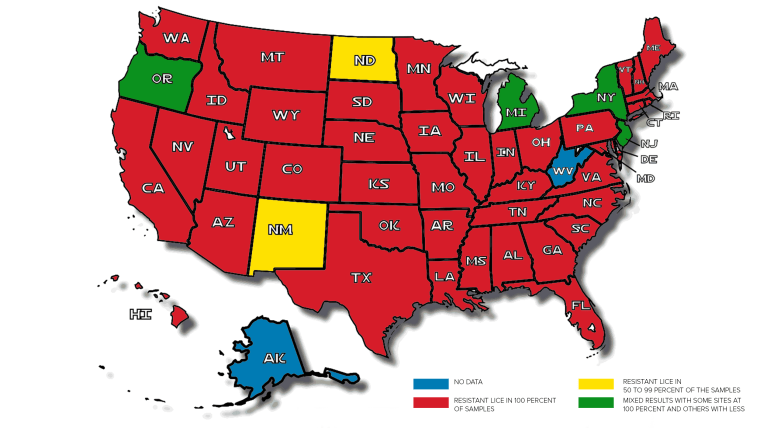Head lice, already the bane of parents sending children back to school, have become a much more daunting problem in recent years. As increasing numbers of the bloodsucking bugs show resistance to treatments, parents should skip over-the-counter remedies and go straight to prescription medications, many doctors suggest.
In fact, effectiveness of OTC preparations had declined to 25 percent, a level described as being "no better than placebo” — even with nit combing, a review article published in Pediatric Dermatology late last year found. Worse, even higher doses of the OTC product aren't any more effective, researchers said.
Dr. Kenneth Polin became aware of the growing problem of resistance more than two decades ago when his 5-year-old daughter came home with lice.
“We used the over-the-counter stuff and it didn’t work,” said Polin, a pediatrician at Lurie Children’s Hospital of Chicago. “When we called the company, they blamed us, saying that the patient just didn’t know how to use the product.”
As the percentage of resistant lice has increased, Polin has adapted his advice to patients. “I tell families not to bother with the over-the-counter stuff,” he said. “It’s not consistently effective. I recommend prescription medications.”
The prescription medications are “very safe,” Polin said. “And they are all very effective. I’ve not seen any resistance personally and I’ve not seen anything about resistance in the medical journals either.”

Parents who discover lice in their children’s hair should just call their pediatricians and ask for a prescription to be called in to the local pharmacy, Polin said, adding that most pediatricians would do the same. “You have to understand what the family is going through,” he said. “There’s a huge psychological impact.”
Hope on the horizon?
It’s also important to clean up all bed linens and coats, Polin said, adding that sometimes lice spread by crawling from one child’s coat to that of another.
Another solution to the problem of lice that have crawled from the child onto household furniture and fabrics is to spend the night in a hotel.
“Off the human body lice they can’t live more than a day,” he said.
There may be some good news on the horizon, said Kyong Sup Yoon, an assistant professor in the department of biological sciences and environmental sciences at Southern Illinois University Edwardsville. Yoon was coauthor of a 2016 study showing that resistant strains had spread to nearly every state as well as the 2016 review.
“Currently, several companies are in the process of developing new pediculicides,” Yoon said. “I hope this will give us some options to implement more efficient resistance management.”
Home remedies little help
As for home remedies, there's no evidence that any work. Dr. Robin Gehris, chief of pediatric dermatology at the Children’s Hospital of Pittsburgh traces their popularity to advice given by a multitude of school nurses.
"Olive oil, mayonnaise, Vaseline, these are all treatments I wouldn't recommend," she told TODAY in an earlier report. "But I hear school nurses recommending them all the time."
The Centers for Disease Control and Prevention finds no evidence that mayonnaise, margarine, butter or olive oil help, but Gehris doesn't completely reject those therapies.
"If you want to use mayonnaise as an adjunct, I'm OK with that," Gehris said. "Theoretically, it could work if you put it on thickly enough that the lice aren't able to breathe. But it's hard to imagine that you could get it on thickly enough to really do the trick."
A previous version of this story referenced lice jumping from person to furniture. Head lice don't jump, hop or fly, they crawl!